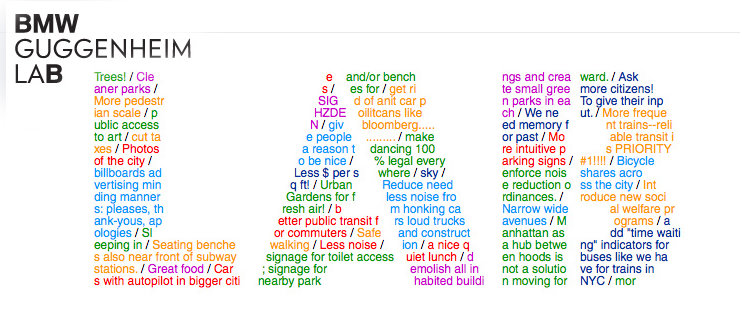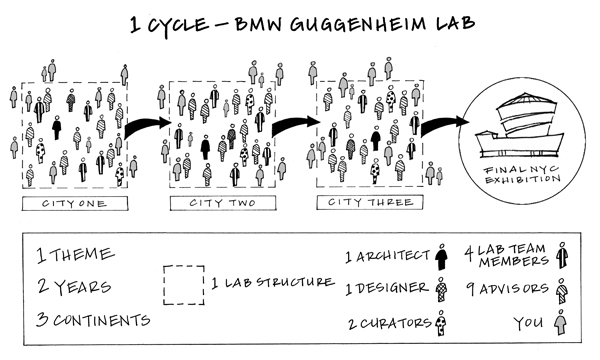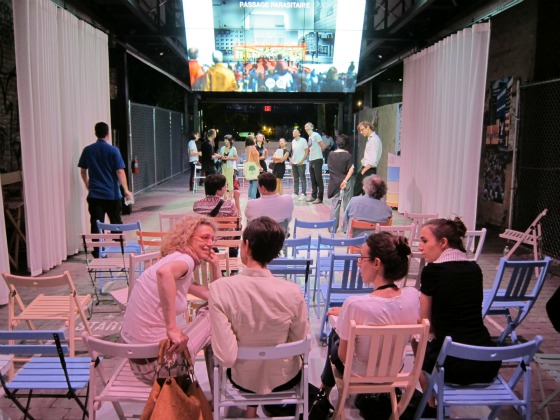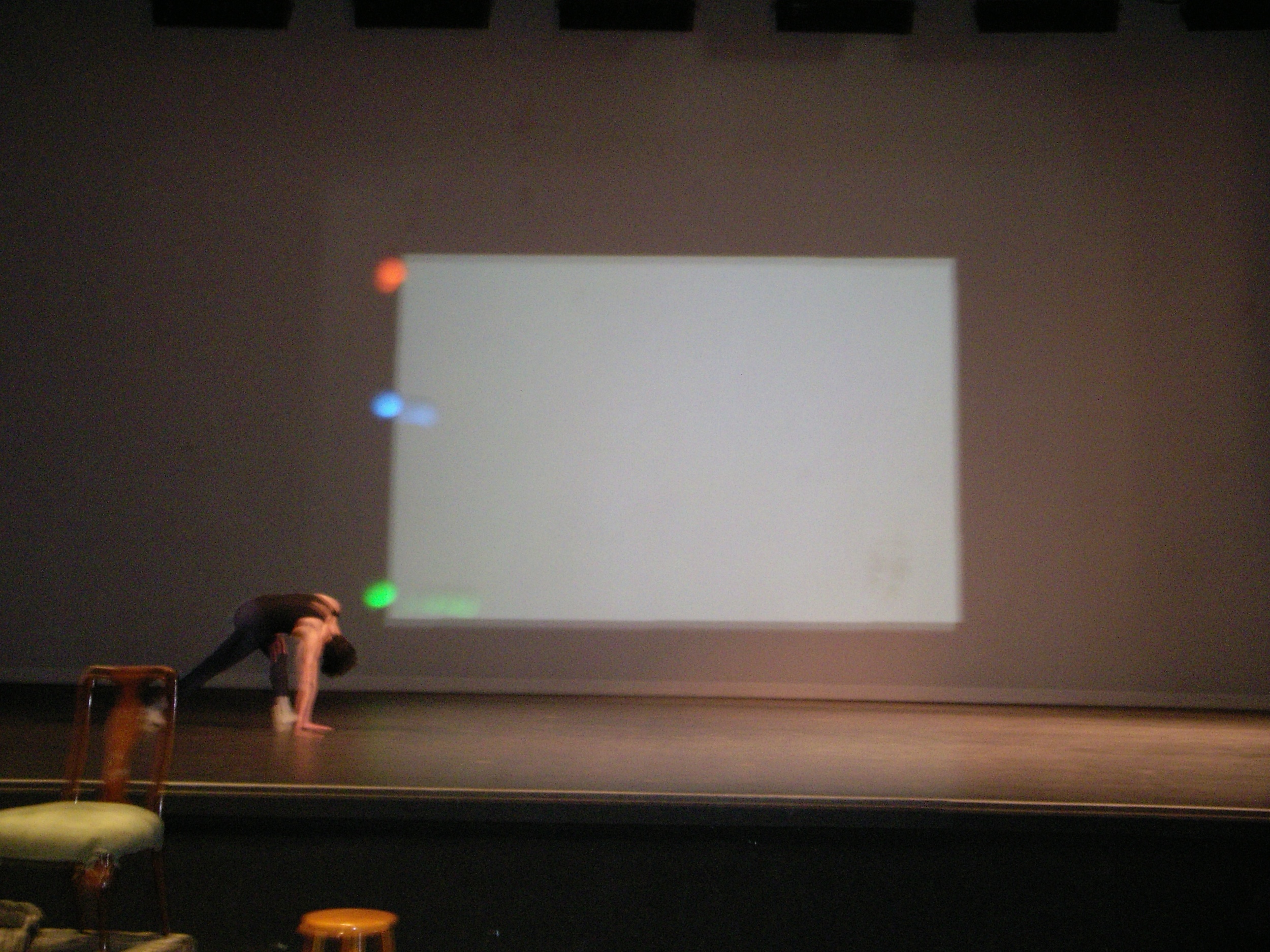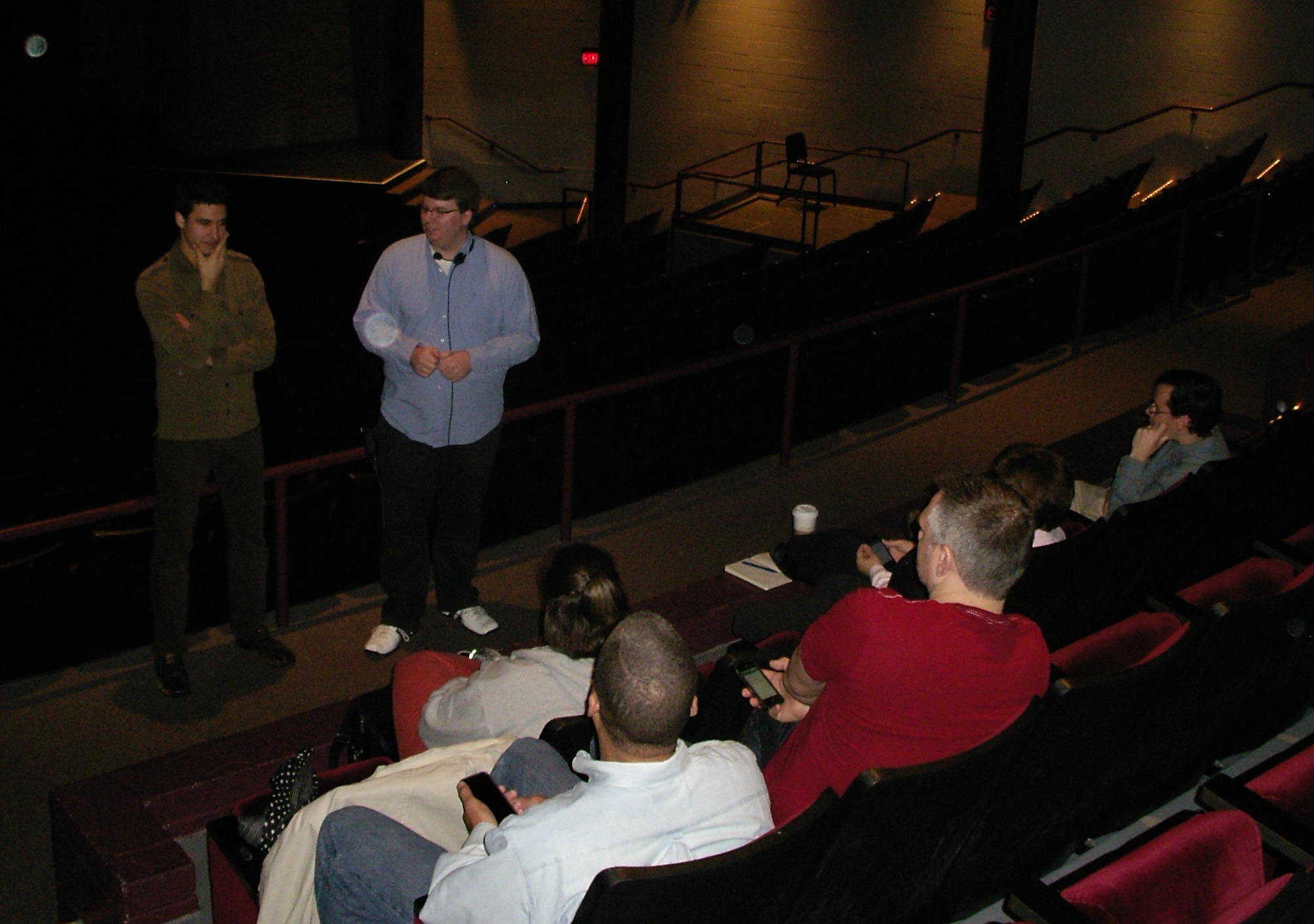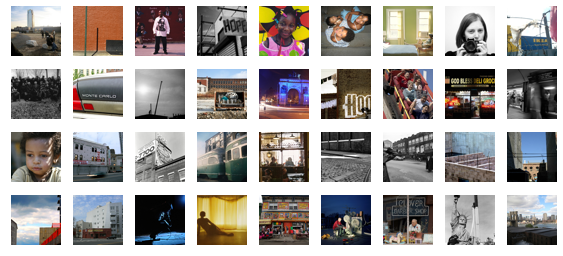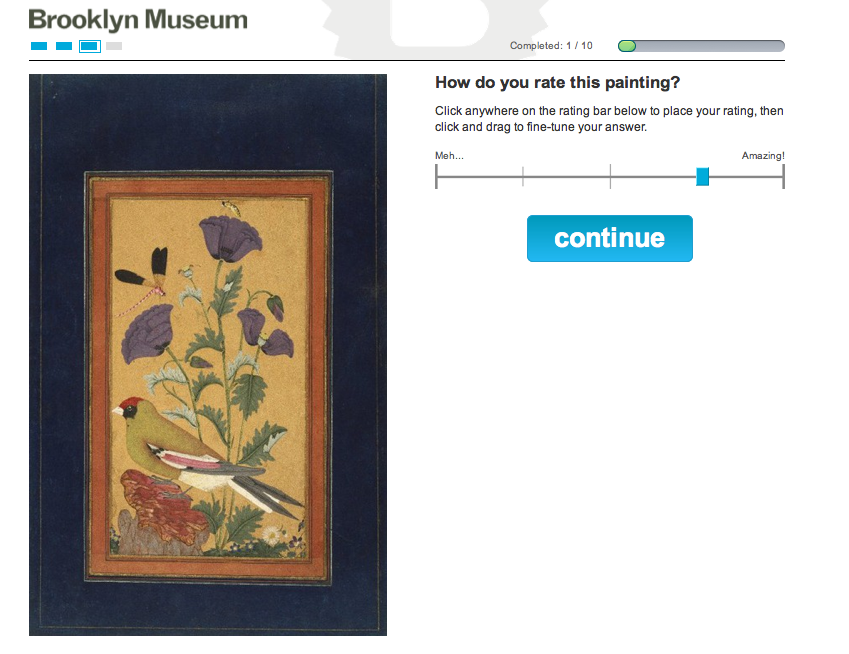As technology continues to shrink the world we live in by bridging communities across the globe, collaborations between artists separated by space are becoming more common. In this white paper, AMT Lab contributor Nora Fleury looks at the ways new technologies are influencing this increased collaboration. With a specific focus on team communication applications and cloud-based document sharing systems, this is a useful resource for managers struggling to foster communication between artists separated by geography. Click here for the full report.
PIPS:lab Diespace, Interactive Multimedia Experience
PIPS:lab recently made its US debut during a festival featuring Dutch artists here in Pittsburgh. The Amsterdam group has been performing together for about a dozen years. The work that they performed was categorized as absurdist media theater and was a short evening length work without intermission. The use of technology for this performing group is integral. The performance itself was noteworthy for its innovation on a number of different levels. It is worth noting, however, the problems that PIPS:lab had in functionally executing the performance due to glitchy technology. The performance, Diespace, was essentially an introduction to a fictional new social network site that audience members were encouraged to visit after they die (or die in order to visit). The actors polled the audience about their opinions regarding whether or not there is life after (or before, humorously) death. These polls were conducted with a cool audience participation tool of light capture setup where the audience essentially wrote on a screen upstage.
The other insertion of tech into the performance involved video/audio remixes of various clips taken of audience member during and before the show. These clips were then edited in real time into the performance. This, in turn, served to engage the audience but through a pretty controlled format. The display of the video and audio taken from the audience drew laughter and made the audience excited and was a high point of the performance lending to greater investment from the collective. Additional audience participate was to be had through a lottery during the show where the faces of the audience were put into a virtual tumbler on the screen upstage. Three audience members won prizes with the grand prize being a premium account for Diespace (which included significant stage time for the audience member who won it).

The performance unfolded at a relatively brisk pace with musical interludes to cover moments where the technology and content was being prepped. The problem with this was that the performers ended up being a bit un-invested in the music and as a result it was hard to be carried away by the performance. It was easy to check out during these scenes through the distractions on stage. It was the sense of this reviewer that there was only one true musician on stage, a fact that was born out by the program notes about the artists backgrounds.
At least three times during the performance there were loud warnings of a computer crash each time forcing the performers on stage to repeat a few moments to a few minutes of the action. This in turn lent to a stutter stop feel to the performance. Execution of Diespace did not look like it was easy and to be certain what PIPS:lab is trying to do is not easy in general. They deserve applause for attempting to stitch together so many constituent elements in the moment. It was fascinating at times to see the failures of the technology and there was rarely a moment where the audience did not have something that they could try to be engaged in. The relative successes and failures of this performance reinforce the point that some technologies have a ways to go before they are both accessible to independent performing artists.
The innovation of groups like PIPS:lab hopefully will be the wave of the future and it is gratifying to see media artists take the stage with musicians and actors. The combination of talents of stage was a rich soup and Diespace was a valuable experience for the insights that it gave with regards to generation of true multi-disciplinary live work.
Creators Project in San Francisco
 Last weekend the Creator's Project garnered significant attention from national media. From the mission statement on the website "The Creators Project is a global celebration of art and technology." and "The Creators Project is a new kind of arts and culture channel for a new kind of world." As an intersection between art and tech it seems appropriate that the blog weigh in and take a look at what they did, how they did it, and the implications. The Creator's Project has major sponsorship from Intel Corp and VICE with significant online free content focusing on mostly short form interview of Creator associated artists. This Project offers similar promise to other ventures to offering culture and arts online to ideas such as On The Boards TV and Jacob's Pillow Virtual Pillow but is already operating on a much larger scale than either of these.
Last weekend the Creator's Project garnered significant attention from national media. From the mission statement on the website "The Creators Project is a global celebration of art and technology." and "The Creators Project is a new kind of arts and culture channel for a new kind of world." As an intersection between art and tech it seems appropriate that the blog weigh in and take a look at what they did, how they did it, and the implications. The Creator's Project has major sponsorship from Intel Corp and VICE with significant online free content focusing on mostly short form interview of Creator associated artists. This Project offers similar promise to other ventures to offering culture and arts online to ideas such as On The Boards TV and Jacob's Pillow Virtual Pillow but is already operating on a much larger scale than either of these.
The Creators Project offers arts and culture online at a scale that is extraordinary for such a young institution. The levels of participation on information sharing that is happening through their website looks unparalleled and should be looked towards as a model for successful integration of technology and the arts. The Creators Project was started in May of 2010 by VICE and seems to have two major interfaces with the public. There is a exhibit/show that has toured around the world each year and an expanding web presence that now counts video downloads in the millions. The content is broken out into six different categories: Music, Film, Art, Design, Gaming, and Fashion and has engaged with artists from all of these areas to provide content online and for the annual festival. They will be rolling out content collected from the event last weekend (March 17-19, 2012) in the coming weeks.
Current content on the website is a mind blowing array of new directions taken by artists in each of the fields. One of the standout artists at the event last weekend was a new work from visual multidisciplinary artist Chris Milk. The installation called the Treachery of Sanctuary incorporated user interaction with digital transformation to look at elements of flight. Visuals of this can be found here.
Anther fascinating example that was found on the Creator's Project website was the Electronic Shadow from France. Electronic Shadow uses imaging technology and software to generate interactive 3D maps of people places and objects. These images then can be used and manipulated in artistic fashions. The implication for this technology would, for instance, be a game changing one for other art forms such as dance.
Exchange of ideas such as Creator's Project bring together the bleeding edge of Technology and the Arts and as such should be a point of engagement for institutions that are looking to modernize and include new audiences (and younger audiences). The artists involved have obviously successfully engaged these audiences already and by following the lead of these success stories arts leaders at more conventional organizations can find hope in a new direction in reshaping structure and content to address the demands of a more complex world.
Building online community: sketchcrawl.com
Seven years ago Enrico Casarosa, an artist working for Pixar went on a pubcrawl. He writes that the spirit of community inspired him to create a community for visual artists that he called Sketchcrawl. The first Sketchcrawl happened in 2004 in over 20 locations in six countires. Since then, there have been 33 Sketchcrawls and the event has grown to almost a hundred locations in over 20 counties and now has a website sketchcrawl.com. The community now has over 3000 members and is still growing. At first, only Enrico was moderating, but Sketchcrawl has since grown to have numerous other worldwide administrators organizing participation and the community has strong leadership in both Asia and Europe as well as in North America.
A Sketchcrawl is a day predetermined thoughout the world, where artists young and old, professional and amateur pledge to sketch for anywhere from 20 minutes to 8 hours. The results of the event day are posted online for the whole worldwide community to see. There are some true gems in these online galleries. Participants speak of both the reward and difficulty of committing to draw for an entire day. They recount the lucidity that comes from a full day of observation and moving from subject to subject. They also comment on the difficulty of focusing their attention for so long. Side by side, these artists are creating a community through a shared experience and their love of art. Alongside their peers the collection of images lead us through a sense of movement throughout the day and objects and people that once were ignored as mundane become visible and interesting.
This community, built through a mutual love of the arts, is a strong sign of the growth of the arts online and should give the arts community at large hope for the future in the face of declines elsewhere. The next Sketchcrawl is on January 21, 2012. It is easy to sign up and there are also multiple social network sites for the community at large and for individual city groups.
What Makes Me, innovation from Down Under.
This website is called “What Makes Me”. There are three different sections: What Makes Me, What Makes You, What Makes Us. Each person claims a cube, a cleverly designed multimedia enabled object online and they decorate it with their images, video, and audio files. Each one is very different. The first twelve entries talk about why each individual loves a certain art form or forms - whether it be dance, circus arts, graffiti or something else. All of them are touching and told from the heart. There’s a retired nurse that found out her next door neighbor was a circus performer and has since fallen in love with the circus. There’s a professional rugby driver who drives around looking at the graffiti all over the city. There’s a professional cook who while catering a party, discovered dance for the first time and has since developed a personal relationship with the choreographer.
The common thread that runs between most of these testimonials is the personal connection built with a specific artist or the arts in their neighborhood. It’s about relationships, rather than facilities, and community as the key to these relationships.
The idea around this project was to counteract the perception that the arts in Australia are “associated with images of snobbery and inaccessibility”. The project is run by a company called Wanted Digital and initiated by the Australia Council for the Arts. The participants of What Makes Me are cooperating to build something together- it’s a game. A game that is getting the attention of philanthropic organizations in the US. Wolf Brown recently used this interactive project as an example of participation in the arts in their recent study commissioned by the Jame Irvine Foundation “Getting In On the Act - How arts groups are getting opportunities for active participation”.
What Makes Me is worth taking a second look at. The project engenders enthusiasm that isn’t created from simply being a spectator. Anyone in Australia can be a part of it and there is a hefty presence on the site from diverse populations with Aboriginal people, the disabled, and immigrant communities being well represented. Participants post links to their cube, to their facebook, to their twitter, to other social media sites. The individual act of creation combined with the community have a ground swell effect and foster even deeper love for individual artists and the arts contributions to the community.
A Collaborative Affair: When Art Meets Business
One doesn’t often find commonalities between the world of art and luxury automobile technology. While it is common for businesses in different industries to create partnerships, joint ventures, or mergers, the idea of collaboration between businesses and art organizations was often dismissed on the grounds of artistic and monetary differences. But in a world of ever increasing intersections and interconnections, this notion is fast becoming obsolete and arts organizations are no longer insular entities that are oblivious to their formidable counterparts in the business world. The mutual desire for collaboration between the art and the business world is becoming stronger because one can provide business acumen and technical expertise while the other can leverage its strengths in creative thinking and critical analysis. Hence, when the world of art opens the doors of collaboration to different industries, the results can be unexpected, intriguing, and just plain extraordinary.
A museum that is clearly benefiting from strategic partnerships with companies in the world of business and technology is the Guggenheim. It made headlines in 2010 when it collaborated with YouTube, Intel, and Hewlett-Packard to create A Biennial of Creative Video. Essentially an homage to the world of online video, the biennial enabled Guggenheim to showcase extraordinary videos created by ordinary people in the YouTube community.
A year has passed but the Guggenheim is not one to take an innovation vacation, it has recently partnered with BMW to create the BMW Guggenheim Lab. The lab’s name may lack inspiration but the crux of its efforts will most certainly revolve around the axis of innovation. In fact, the lab is “a mobile laboratory travelling around the world to inspire innovative ideas for urban life.”
Over a period of six years, a team of interdisciplinary vanguards “in the areas of urbanism, architecture, art, design, science, technology, education, and sustainability” will travel to a total of nine cities in an effort to resolve the issues surrounding urban life. The lab will center around a specific theme for each two year cycle, the first of which is Confronting Comfort. The journey has already begun in New York City, where the lab has been hosting a series of free programs and experiments designed to help the public not only confront but also improve comfort in the quintessential metropolis. Next it will travel to Berlin and finally, Mumbai, concluding the first two year cycle with an exhibition at the Guggenheim in 2013.
If you do not happen to live in a sprawling metropolis, you can still play Urbanology; an online game that helps you ideate your dream city after asking you a series of questions that will gauge your societal, moral, and sustainable compass. You can also follow all the events on their blog and read intriguing posts such as “ten tips on using your city as an engine for joy” or “your brain on commuting.”
Apart from the games and interesting events, let’s hope the initiative’s denouement will result in change, both inside and outside the realm of the Guggenheim, because we all know that the power to act on issues that arise in metropolises, such as those of transportation or pollution levels, rests primarily in the hands of the government.
Doubts aside, the Guggenheim BMW lab certainly is a novel and unique project that exemplifies the synergies that arise when two unlikely organizations team up. Earlier this year, an article in the Economist argued that businesses have much to learn from the world of art and the opposite is no less true, the possibilities for mutually beneficial relationships are endless. As for the many arts organizations and corporate businesses that regard each with an air of mere acquaintanceship, it’s time they sat down to have a cup of tea.
What's the Big Idea? 5 Key Takeaways from the Museums and the Web Conference
Arts and Technology Round-up: Museums and the Web Edition
Happy Friday everyone! For this arts and technology round-up we decided to try and hone in on a few of the awesome projects that we saw at the Museums and the Web conference last week. Up first are our picks of some of the best and most innovative projects. After that, the winners of the Best of the Web 2011 awards from the conference.
Technology In The Arts Picks
Zooniverse - This group marries together the researching needs of the scientific/historical communities and the power of crowdsourcing. By creating a series of interactive web portals, Zooniverse creates communities of "Citizen Scientists".
PhilaHistory - Philly based GIS firm Azavea worked with the City of Philadelphia to create a platform for linking historical photos of the city to their real world locations using geo-location and augmented reality.
One To One with the Artist: Ai Weiwei - A simple idea with a great effect, this project from the Tate allowed museum visitors to record and upload a video in the gallery and have a video dialogue with the artist Ai Weiwei.
The WALL - The Museum of Copenhagen's giant multi-touch multimedia screen installed in one of the central squares of Copenhagen.
ARTfinder - A new recommendation engine for artwork, this site works very much like Last.fm, taking your current interests and using them to introduce you to new works.
The Collective - Sounding a little bit like a bad 50's sci-fi flick, The Collective is the Denver Art Museum's interactive website/online programming space and a new way of connecting and bringing in the Denver community.
MoMA Learn - An extremely in-depth arts education web portal, the Museum of Modern Art's education department went all out on this one.
ARtours - The Stedelijk Museum's innovative augmented reality program.
The Best of the Web 2011
Education & Best Overall: The ACMI Generator
Mobile: The AB EX NY iPad app
Exhibition: Henri Cartier-Bresson: The Modern Century
Innovative: Nationnaal Historisch Museum / Museum of National History
Museum Professional & People's Choice: Smithsonian Web and New Media Strategy Wiki
Long-Lived: Exploratorium.org
Research/Online Collection: Portable Antiquities Scheme
Audio/Visual/Podcast: Access All Areas podcast
Project by a Small Institution: ASI: Archaeology Scene Investigations in North County Louth
Mobile Audience Participation with Jonah Bokaer and the Ferst Center
Audience interaction has become a pretty major trend this year and arts organizations around the country are experimenting with different ways to engage their audiences. But how does one go about making their experience a participatory one? Artist Jonah Bokaer and the Ferst Center for the Arts at Georgia Tech decided to approach the issue using mobile technology. Jonah Bokaer is an award-winning choreographer and media artist participating in the Ferst Center's first ever year-long dance residency program, ARTech. Jonah worked closely with students from the Georgia Tech Music Technology Program to develop MassMobile, a smartphone app that acts as an interactive platform for audience members to participate by affecting the stage in different ways. On April 2nd, MassMobile will premier with Jonah's new work FILTER at the Ferst Center.
I had to opportunity to speak with Jonah as well as Stephen Garrett, one of the graduate students on the MassMobile development team, and dancer Adam Weinert, who can be seen in the sneak peek video at the end of this post.
Where did the idea to include the audience in the performance, through a mobile app, come from?
Jonah - Well, in 2004 I made a work called RSVP, which planted 12 cellular devices in the audience. We used those devices and their ringtones to create the music for the piece. And that was engineered from offstage by the composer. But, when doing some initial research down here and planning this production called FILTER, I wanted to put forward the idea or the proposal that there could be interaction or intervention even, with the show. And maybe Stephen can take it from here, but we spoke with Jason Freeman and the Ferst Center and this relationship started.
Stephen – Yeah, and I think Jason’s idea, who is my advising professor on my master’s project, was to create a system that allowed for a rapid deployment of audience interaction devices through peoples’ mobile phones. So the idea came from Jason through some previous mobile development work and with several other projects, to create an iPhone and android application that will allow any type of input that the phones will allow. Whether that be an accelerometer, motion data, text messaging, touch data, drawing…anything that the phone will accept, to try and incorporate that into the performances in some way.
What are some of the direct ways that the audience is affecting the performance through MassMobile? Does it affect the lighting or are there sound elements that change?
Jonah - Well, one thing I just want to clarify is that this production will premier in it’s full form here in Atlanta on April 2nd. So we’ve had a six or seven day production period in Avignon France and we premiered the choreography, but MassMobile and these technological components have not yet been unveiled and actually this week we are holding a workshop with invited public to interact with it further.
So in terms of how the audience affects the performance? We’ve identified four ways for potential interaction. In particular I wrote in one section of the performance which is very much open-ended and is a 9 minute section which can basically be reconfigured a bit. Specifically the lighting is influenced. We worked closely with Aaron Copp, who is my lighting designer, to integrate that into the performance.
Stephen – And certainly MassMobile itself, the way that the app can interact with a piece, is not set in stone. It’s a creative conversation that is always happening. But specifically for this piece, for one of the sections that involves interaction during the pre-show, the audience is quite literally plugged into the lighting board through their app.
The actual technical details of the connection is that the mobile app is connected through a client server relationship to one of our servers here at Georgia Tech. Then there is a laptop that sits in the lighting booth that constantly pulls for information. Based on what items people have selected in the app, the laptop is connected directly to the lighting board and will instantly turn lights on and off. You can change color palettes and things like that pretty much instantly.
Did you build MassMobile specifically for this performance or is this a platform that could be used for other performances/performers?
Jonah – I would almost say that it is still in progress. But, you know, Aaron Copp and I have known each other since 1999 and have been building work together for a long time and often in our creative discussions we would say, “Is there some way to interface or interact?” As opposed to working with just video or with sound, lighting is so integral to these performances that MassMobile seems like a natural fit. I think that for light and choreography I am working in very particular ways. For larger applications of MassMobile I know there are many options.
Stephen – So MassMobile itself is the platform and the app, and is still in pretty active development. Working with Jonah and his FILTER has been a great way to beta-test the app and see it grow to more of its current capacity. My professor Jason Freeman already had the plan to use the application in a live music notation work with saxophone where the audience could directly affect the notes that the performer is seeing onscreen. So there are other uses for MassMobile in the arts imaginable.
Could you speak to the importance, for you, of having participation from the audience?
Jonah – Well, I should say that my degree is not in choreography, it is in media and visual arts. For my thesis I focused on the myth of interactivity and focused on a lot of mid to late video work in the 1980’s and 1990’s. My sense was that there is a certain parallel between what we could call this myth with interactivity with video, but also with performance. Just because it’s time based, it’s not necessarily interactive. This is one area of focus of mine in terms of creating performances.
I guess the impulse to say that an audience could interact, is still pretty much in progress. So far, at least in this stage in the piece, we’ve only had pre-show interaction. It’s kind of an open question.
I think some major conventions of theater are called into question, for example having the phones on during the show, the light of a cellular device on in the theatre. Some artists would consider this distracting, but in this case we are actually inviting it. There are certainly questions of attention and attention span. We’re sort of walking into this project and saying that it is assumed that this will be unusually structured.
So why create such an unconventional performance? Well really, the participation is a part of why we wanted to open this out. Because instead of really disrupting or undermining a performance, we wanted people to be able to engage and help the author.
Stephen – The way we’ve enabled that interaction is a very direct and literal effect the audience can have with the lighting of different parts of the stage. [The pre-show] is an opportunity for people to come in and the curtain is open and they can see the initial set and it gives them a chance to explore. Our hope is that creates a deeper and more meaningful bong throughout the rest of the performance. That [the audience] has really explored the set and can experience it on a different level.
In addition to the interaction between the viewer and the stage, do you think that this program will cause the audience to interact with each other?
Jonah – The way that we piloted MassMobile was to have six mobile devices distributed internally to members of the creative team, producers and close colleagues over the course of a few days. I did note, on a couple of occasions, the social interactions that would occur person to person. Maybe Stephen would like to address any interactivity within the platform itself.
Stephen – We did see people that were using the app that were sitting next to each other sort of communicating in person and coordinating their efforts, but at this moment that’s not something we’re doing. [Interactivity within the platform] is something we are looking at in the future of MassMobile. More specifically looking at how do we enable or make sure that people have their own voice in their interactions with the performance.
From a performer’s perspective, what is it like working with something like MassMobile?
Adam – From a performer’s perspective, I think what excites me most about this kind of initiative is that as a performer we’re always looking for new ways to engage the audience and make each articulation of the performance event unique and special and fresh. I think that MassMobile can be a unique way to do that.
The other thing I really appreciate is how we’re using this mobile technology and multimedia to make more personal the performance. Which I think is rare and hard to accomplish.
If you live in the Atlanta area I highly recommend heading over to the Ferst Center for the premiere of FILTER on April 2nd. You can find more information about performance times and tickets at the Ferst Center's main website here. Until then, he is a sneak peak of dancer Adam Weinert and MassMobile.
MassMobile App Sneak Peak from Ferst Center on Vimeo.
Twitter by Example: Our Favorite Tweeps
Why are some Twitter users so effective at getting your attention while others fall flat? What can you do to make your tweets stand out in a crowded feed? By taking the time to reflect on some of the engagement techniques you see cropping up amongst your fellow Tweeps, you can invent your own ways to harness the power of Twitter for your organization. The Technology in the Arts team thought it might be fun to highlight a handful of our favorite Twitter users from the arts sector. Check out these Twitter streams to see illustrations of successful, interesting, and unique ways to use the platform ...
My favorites:
@SFMOMA I love the tone of San Francisco MOMA’s tweets – they do a great job of blending humor with behind-the-scenes photos, museum happenings, and random things like wacky art historical facts. They actively participate in dialogue with not only other orgs but also their Twitter audience - and sometimes they even project their audience’s Tweets on their museum walls…now that’s some serious tweet integration.

@TheSoapFactory With a staff of only five people, this Minneapolis nonprofit gallery proves that small organizations can make a big impact via Twitter. Their tweets are conversational, friendly and often funny – and they actively tweet their support & enthusiasm for local arts happenings and the artists they work with. @TheSoapFactory loves shout outs, and always takes the time to publicly say “thank you” to volunteers and interns in their tweets. Their warmth and graciousness on Twitter creates a personal connection with their audience – which goes a long way in the tweetosphere, despite their relatively small size.

@yokoono With nearly 1.9 million followers, Yoko’s got a worldwide Twitter audience, and she keeps them engaged in a variety of innovative ways that other artists and arts organizations can learn from. Each week, she posts a series of responses to questions that are tweeted to her – showing that she really cares about engaging in dialogue with her fans. Her own tweets are powerful in their simplicity and she’s always got a positive message to share. She encourages followers to participate by creating their own positive messages, too: the Imagine Peace Tower, an art installation located in Iceland, lights up a few weeks each year with tweeted "wishes" related to peace and love. So far, over 1.3 million wishes have been sent via @IPTower, and it's happening now through March 26.

Amelia's favorite:
@SUEtheTrex at Chicago's Field Museum. "Hi. I'm Sue, I'm a Leo, I like meat, Chicago, the movie Jurassic Park, and what else? Oh yeah, I'm the world's greatest apex predator." This tagline says it all about Sue the T-Rex--she's sassy, hilarious, and about 2 million years old. That doesn't stop her from having conversations with present-day life forms, tweeting about current events--everything from Thanksgiving to Women's History Month--and educating about the T-Rex. A great example of employees personalizing an institution.

David's favorites:
@artfulmanager Andrew Taylor, author of the Artful Manager blog and Director of University of Wisconsin’s MBA in Arts Administration, always provides great resources for arts managers. His retweets tend to pull from sources that I may not be following – which opens me up to new content that I might not otherwise stumble upon.

@travisbedard Travis Bedard, Artistic Director of Austin’s Cambiare Productions theatre company, provides a great combination of humor and informative posts from the theatre community.

@Brandinyourhand International arts consultant Roger Tomlinson always offers thoughtful information and insights from across the Pond.

@JamesUrbaniak New York stage, screen and voice actor James Urbaniak is a subversive pleasure. Witty, sarcastic and irreverent – a wonderful 140-characters-or-less chucklefest.

Tom's favorites:
@MuseumNext is one of my favorite sources for finding out not just what is going on with museums now, but in the future as well. Through their blog, publications and their conference, MuseumNext highlights the ways museums are using technology to become more participatory and engaging for audiences. Plus, these are the folks that brought us the wildly popular twitter campaigns Ask a Curator, Follow a Museum and most recently Picture a Museum Day.

@MuseumNerd Oh, the Museum Nerd. That Brooklyn-based lover of all things art. Museum Nerd is an anonymous persona who tweets about his/her experiences as they weave through different exhibits. Besides the color commentary, Museum Nerd is great at engaging both visitors and museums on Twitter while exploring exhibits and other art world happenings.

@NancyProctor The Head of Mobile Strategy and Initiatives for the Smithsonian Institution, I feel like Nancy Proctor is the Queen of museum mobile tech on Twitter. I check her feed for the latest developments in museum mobile tech, thoughts on best practices and to find who is experimenting and how. You can usually find her dropping some mobile tech knowledge with the hashtags #mtogo and #simobile.

Tara's favorite:
@atane Atane O. is one of my favorite music and audiophile nerds to follow on Twitter. He's currently a blogger for the Elements of Jazz blog, and always has cool pictures, videos and music clips to share via his Twitter stream. He also has an amazing vinyl collection (and great turntables!).

Now, it's your turn: who do YOU love on Twitter, and why?
Museum crowd-curation and the way we live now
Should more museums follow the Brooklyn Museum’s lead?
Recently, I helped curate Split-Second: Indian Paintings, a show for the Brooklyn Museum. To do so, I simply visited their website and participated in an online activity. It took me about ten minutes, and it involved briefly looking at images, clicking on those paintings that I found most intriguing and rating other paintings on a sliding scale.
My participation in this process got me thinking not only about Indian art, but also about how my own perceptions of art in general might be shaped, and how my aesthetic tastes might compare to the sensibilities of the general public. Even more interesting to me was that this experiment in crowd-curation felt like the inevitable extension of the movement towards a more participatory culture.
What is it?
Museum crowd-curation enables the general public to become a part of the curatorial process by helping to determine, through an online platform, the artwork to be included in a physical exhibition displayed in a museum’s gallery.
The Brooklyn Museum pioneered crowd-curation three years ago with its photography exhibition Click! . First launched through an open call for artists to submit photos related to the theme of “The Changing Faces of Brooklyn”, the artwork was then made available online for anyone to curate. Perhaps most interestingly, the Brooklyn Museum staff took a transparent and scientific approach to the experiment, publicly sharing data and thoughtful analysis every step of the way. Check out Brad's Technology in the Arts podcast with Shelley Bernstein from 2008 to learn more about Click!
Now, Bernstein and the folks at the Brooklyn Museum are offering a new spin on crowd-curation by injecting theories of connoisseurship to Split-Second: Indian Paintings. Based on ideas from the book Blink by Malcolm Gladwell, Split-Second seeks to explore how our first impressions might affect our perceptions of art as well as the production of a museum exhibition. In the end, we’re left with an engaging viewer/curator experience that subtly mixes the professional with the amateur.
Why is crowd-curation so intriguing?
Increasingly, we are becoming a culture of curators, especially in the virtual world. We spend our time organizing media according to preference, grouping our memories into online photo and video databanks, and “liking” and commenting on things that other people share. What this means is that arts audiences are coming to the gallery with a newly emboldened sense of organizing and presenting content. Arts organizations therefore need to play an active role by creating opportunities for meaningful engagement.
Organizations that are at the forefront of online audience engagement are presenting ideas that go beyond simply offering information about programming. Instead, they are experimenting with different ways that audiences can become co-creators of content, which can then lead to a sense of ownership in the institution. But crowd-curation should not be simply a matter of presenting art works and having a voting contest in the sense of American Idol. Rather, arts managers need to envision a place of meaningful dialogue between their organization and their audience.
Crowd-curation is exciting because it is a clear illustration of the changing dynamics of the audience/museum relationship. It takes creative online participation and literally translates the collective online vision into physical space. Along the way, it can stimulate creative thinking by:
- Getting the participant/curator to think about her own internal perceptions of art, and perhaps inspire her to dig even deeper through self-reflection. What struck me most in my experience as a curator of Split-Second was how successful the exercise was in getting me to think about not only the art in the show but also my own understanding of visual culture.
- Creating discussion, based upon the collective decisions of the audience, about big-picture questions, like: How is artistic value determined? Is general consensus achievable in determining artist merit?
By putting the internal and collective processes together, crowd-curation has the potential to achieve multiple levels of meaningful contemplation. Of course, arts managers may feel like they are taking a significant risk. They may fear that the artistic content chosen by the masses will not constitute a “quality” exhibition in the traditional sense. And, perhaps worse, if crowd-curation IS able to produce a quality exhibition, then what is the point of having all of these professionals around? However, as sites like Wikipedia or perhaps the “comments” section of any website have shown, opening up the production of content to crowds is precisely the time when professional, articulate viewpoints are needed most.
This is not to argue that crowd-curation methods should or will replace traditional curatorial models. In fact, it doesn’t make sense for all art museums to try it (based on a number of factors such as the nature of the audience, resources available, the nature of the exhibit, etc.) Even so, crowd-curation is an innovative approach to breaking down the barriers between art museum and audience, and it’s a fascinating reflection of the way we live now.
Do You Have Trust Issues? - Data Sharing and the Arts
This post also appears as a featured article on artsmarketing.org, hosted by Americans for the Arts.
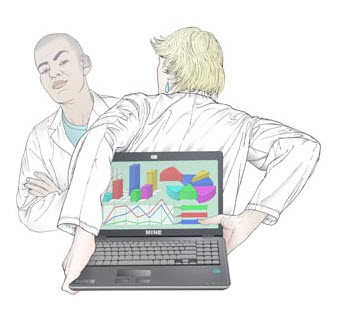
I recently had the privilege of facilitating a roundtable discussion in New York City focusing on issues related to data sharing among arts organizations. As Tiffany Bradley, Development and Marketing Specialist for Fractured Atlas, recently wrote:
As more organizations lead collaborative efforts, the implications of sharing data come to the forefront. Data sharing – whether for marketing, ticketing, fundraising purposes – raises a host of issues. Does pooling information about patrons lead to greater revenues for all parties? Or do organizations risk a negative response from patrons?
Hosted by Fractured Atlas as part of their “Issue Brunch “series and streamed live on the Internet via Ustream, the conversation featured the thoughts and voices of six arts professionals working with arts organizations, including NAMPRadio’s Maris Smith. While the roundtable covered a lot of ground surrounding the benefits and challenges of sharing data between arts organizations, the issue of trust emerged as the bonding force at the heart of all data sharing relationships.
Let’s face it. The idea of giving our data to someone else is anxiety-producing for most organizations. How do we know that they will abide by our agreement and use the data ethically? Yet, if we never place our trust in others, thereby initiating the relationship-building process, then we will never reap the benefits that may come from a data sharing relationship.
Now before someone out there becomes paralyzed with data sharing anxiety, relax. You already engage in data sharing relationships based upon trust. For example, many of us utilize Google Analytics to track visitor interactions with our websites. When we agreed to use Google’s service, we also agreed to share our data with Google. We acquiesce that Google will use our data to contribute to the web traffic data they have aggregated over time and for particular types of websites. However, we trust that Google will never give our websites’ specific data to anyone else without our permission.
Okay, I can hear some of you out there saying, “But that is an example from a service provider; it’s different to talk about sharing data with another arts organization.” No, it’s not. Data sharing relationships between arts organizations should have clearly articulated agreements detailing the data to be shared, the limits of what may be done with that data, and what contributors of the data will receive in return. Yes, these should be written agreements – or at least electronic agreements executed with digital signatures.
And just in case you skimmed over the last item of things to be detailed in data sharing relationships, I’ll rephrase myself. Data contributors should receive something in return for contributing their data. We are talking about data sharing relationships, not data giving relationships. Now, the quid pro quo of a data sharing agreement may simply be that the data collecting organization will provide contributors with overall or customized reports. That’s fine as long as the data contributors have a clear understanding of what they will receive in exchange for adding their data to the larger pool. Far too often, organizations may feel pressured to participate in data collection initiatives and surveys. One of the most important ways that you can maximize your data sharing relationships is to make certain that it is mutually understood by all parties what you will be receiving as a result of contributing your data.
While trust must be given, it must also be earned and respected in order for any data sharing relationship to grow. For example, Elliott Marketing Group has been working on two data sharing projects with numerous arts organizations in Pittsburgh, PA. In 2004, they worked with the Pittsburgh Cultural Trust to establish the SmArt database linking patron files for arts organizations in the city’s downtown cultural district for targeted marketing campaigns. In 2007, they partnered with the Greater Pittsburgh Arts Council to launch the STAR Direct Marketing Database, which allows smaller and mid-sized arts organizations in the Pittsburgh region to pool their patron data and utilize consulting services as well as “best prospect” lists for more efficient, targeted promotions.
The success of these data sharing programs did not happen overnight. The arts service organizations, the organizations contributing data, and the marketing group have spent years developing trust relationships with each other. Now, they have years of collaborative data, and the participating organizations clearly understand what they must contribute to the project and what they will receive in return. With each successive year, the data deepens. Correspondingly, the level of trust each of the contributing organizations has with the arts service organizations and the marketing group also deepens.
A final note on trust in data sharing relationships – don’t break it. Once trust is broken in any relationship, it rarely, if ever, regains its previous depths. For many of us, our data is a precious resource not to be taken lightly. So when a partner breaks our trust with them, our instinct is to take our data and end the relationship. When you negotiate the agreements for your data sharing relationships, always be certain to include an exit clause.
As I mentioned at the top of the article, the issue of trust is just one of many areas that we discussed during the roundtable on data sharing. To learn more about the roundtable, check out the preview video below or view the full discussion at Fractured U.
Data Sharing & Arts Organizations - Take Part in the Conversation
 Our friends at Fractured Atlas are relaunching their Issue Brunch series and have asked me to facilitate a discussion on the benefits and challenges of data sharing among arts organizations. As Tiffany Bradley, Development and Marketing Specialist for Fractured Atlas, recently wrote:
Our friends at Fractured Atlas are relaunching their Issue Brunch series and have asked me to facilitate a discussion on the benefits and challenges of data sharing among arts organizations. As Tiffany Bradley, Development and Marketing Specialist for Fractured Atlas, recently wrote:
As more organizations lead collaborative efforts, the implications of sharing data come to the forefront. Data sharing - whether for marketing, ticketing, fundraising purposes - raises a host of issues. Does pooling information about patrons lead to greater revenues for all parties? Or do organizations risk a negative response from patrons? Integrating the range of software that arts organizations use is also a problem in its own right.
This panel discussion will be streamed live on February 11, 2011 at 1:15 pm EST via UStream at http://www.ustream.tv/channel/fracturedatlas. Online participants will be able to engage one another in discussion and submit questions for the panel.
Panel participants include:
- Deborah M. Abramson - The Pew Charitable Trusts
- Joe Harrell - Alliance for the Arts
- Adam Huttler - Fractured Atlas
- Barbara Janowitz - Theater Subdistrict Council/City of New York
- Chrisopher J. Mackie, Ph.D - Open Health Tools
- Maris Smith - Situation Interactive
So what has your experience been like with data sharing among arts organizations? What benefits have you received? How did you approach the organizational and technological challenges? Leave a comment below and be sure to join us on Friday for what is certain to be an engaging conversation.
Internet Revived the Music Video Star
On August 1, 1981, America was introduced to the cultural phenomenon of Music Television. The television network revolutionized the world of music programming and would forever change the landscape of the music industry. In addition to promoting music through traditional radio, live performances and albums, musicians began to utilize the medium of television to promote their singles. Independent and underground musicians also took advantage of this new technology by shooting lower budget videos to distribute on local cable access shows that were similar to MTV. The cultural innovation of music videos has since evolved along with the rest of the music industry. One of the most interesting trends is the advent of interactive music videos on the internet. An increasing number of artists and arts organizations have begun examining the ways in which they can engage and connect with potential audience members and fans online. The dynamic, fast-paced nature of smart phones, social media and other technology has prompted this shift to interactivity and collaboration.
Here's a look at three of the most innovative videos on the web.
1:Arcade Fire’s “The Wilderness Downtown”
One of the most ambitious projects comes from the indie rock band sensation, Arcade Fire. The band designed a video that uses Google Chrome, Google Maps and HTML5 standard to immerse users into a unique, interactive experience. The music video (designed to work best with the Google Chrome browser) prompts users to enter the street address of their childhood homes and creates a custom video based on images taken from Google Maps’ Street View of your childhood home.
Wilderness Downtown Screenshot
Director, Chris Milk (who just produced another collaborative video for Johnny Cash's final studio recording ), has also worked on videos for Kanye West and Gnarls Barkley and is at the forefront of this revolution in music video production.
For more behind-the-scenes information on the shoot, check out Creativity Online's article.
2. Andy Grammer’s “Keep Your Head Up”
Choose Your Own Adventure...
A slight variation on this theme comes from pop artist, Andy Grammer. The video for Grammer's song 'Keep Your Head Up' is a real life example of a 'Choose Your Own Adventure' story and users can choose what actions they want Andy to take in the video. In November, the most popular choices will be compiled into one video and the result will be uploaded to Vevo.
While shooting the video scenes for each choice did not require any specialized equipment, the process of stringing the different choices today required some cutting edge technology. So cutting edge, in fact, that Grammer's label has taken an equity stake in the company that developed it, according to a recent Wall Street Journal article.
Watch (and interact) with the full video, here.
3. The Cold War Kids’ “I’ve Seen Enough”
'I've Seen Enough' was directed by Sam Jones, who also directed a documentary about the band, Wilco. The video, developed in Flash 10, was nicely compressed to cut down on loading times. The interactive bars at the top allow users to mix and match different styles of the same song, from reggae to acoustic. Users can also click on individual band members to mute or unmute them.
Interactive Videos and the Arts...
While some of the technology utilized in the above experiments can be classified as cutting edge, artists and arts organizations shouldn't be deterred from dabbling in creating their own interactive video experiments. One of the most popular ways musicians have interacted with fans is by streaming concerts, informal jam sessions and interviews online via Ustream. Once logged into Ustream, users can interact with the artist and other fans in real-time. Musicians have also encouraged fans to create slideshows set to their music and upload them to sites like YouTube and Vimeo. As open source software and user collaboration becomes more popular, there's no doubt that more and more artists will be producing this type of content.
A Social Network Apart
Last week Ning announced its new platform for apps. If you are unfamiliar with Ning, it's a service that allows users to create new social networking sites. And, as the white noise generated by the rapidly growing mass of internet users threatens to overpower the individual voice, this may be just the change that an organization needs to break out of the Facebook Group Box. Where is your target audience, and how can your organization stand out when everything that seems most popular is very formulaic? Twitter? Facebook? LinkedIn? Somewhere else? Can you really tell how effective it is, or is your voice getting lost with all the others chattering away on those networks?
As I grow weary of the same-old same-old, I am finding Ning to be very refreshing. It does, however, pose its unique challenges.
The great thing about Ning is that it is customizable, interesting--all the personality of a website with all of the interactivity of a social network! It's like Wordpress, but with members in a community at large. It feels more encouraging, urging members to communicate with one another without as much moderation.
There are downsides, though. A Ning site is one more thing to maintain, and one more place that your audience (fans/followers) has to go. They must be cultivated more actively because the Ning community is not as widespread as that of Facebook. And, if your "people" are hanging out on Twitter or Facebook, do they want to join another community? Will they be less likely to interact because they are already consumed with their activities on the sites that Everyone Else is on?
I am on Ning, and am beginning to delve into the vast array of social networks afforded by my free membership. I find it takes a little more attention and investment than my Facebook time, but I also think that my Ning social networking experience is more varied and engaging. I keep thinking of ways that organizations, artists, could bond together by region on a social network, sharing upcoming events, sharing audiences, and generally cross-pollinating. I'd love to hear about your thoughts and experiences.







